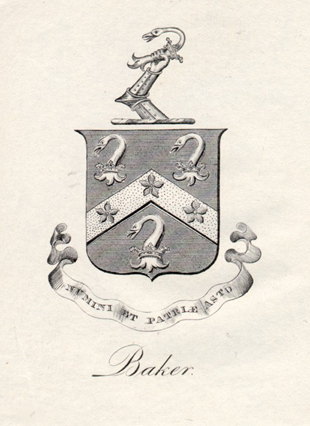

The lineage of the Baker family can be traced back to the time of Edward III, when the family settled at Cranbrook, in Kent. One of the descendants was Thomas Baker of Sissinghurst, Cranbrook, Kent. Thomas had purchased Sissinghurst about 1490; he died 1497. He was the father of Richard Baker, who lived during the reign of Henry VII, and who had married a woman named Joan; Richard died in 1504. Richard's son was Sir John Baker , born 1488, and who followed the legal profession and also became an ambassador to Denmark. When he returned from this assignment, he became Speaker of the House of Commons and later Attorney General. Henry VIII later appointed Sir John Baker to the role of Chancellor of the Exchequer. He was privy counselor to Henry VIII and upon the king's death served in that office to the son, Edward VI, and the daughters Mary and Elizabeth as they took the throne. Sir John (1488-1558) married Elizabeth Barrett (1500-1550) She was the daughter and heir of Thomas Dineley or Dingley, and widow of George Barret).

Sir John Baker had several children. The eldest was Richard Baker , (1528-1594) who married Catharine Tirrell. Sir John Baker's second son was John Baker, (1531-1606),who married Catherine, daughter of Sir Reginald Scott of Scott's Hall Kent. One of Sir John Baker's daughters was Cecily Baker . When Sir John died in 1558, he was interred at Sissinghurst and the estate was passed to his eldest son, Richard Baker. Before he died, Sir John had expanded his small inheritance to include various parts of Kent and Sussex and at his death, he held over 40 manors. Queen Elizabeth I, on one of her many trips taken during her lifetime around her kingdom, stopped at Sissinghurst in August, 1573 and stayed there for 3 days.
Sir John Baker's daughter Cecily married into the Sackville family when she wed Thomas, 1st Earl of Dorset, Queen Elizabeth's Lord Treasurer. It should be mentioned that while the line presented below flowed into a different direction from Sissinghurst, to Canada, the history of the ancestral home has taken many twists. The Civil War in England made it difficult for the upper classes, who had to take one side or the other. At the time the war occurred, Sir John Baker, Sheriff of Kent, took the King's side, and paid for this by having to appeal for forgiveness under the Deed of Amnesty. Parliament eventually restored his estates but he was deep in debt. Over the years the manor declined as the estates were divided up. It was not until April of 1930 that Vita Sackville-West, a direct descendant through the above mentioned Cecily, her husband Harold Nicolson and and their son Nigel Nicolson, visited the property. Despite its run down condition, they fell in love with the place, and bought it. It took many years for the Nicolsons to clean up the grounds around the castle, to plan an extensive and beautiful garden, and to make a home. Vita Sackville-West died at her beloved Sissinghurst in June of 1962. Harold Nicolson continued to live at Sissinghurst and died there in May 1968. A year prior, in April of 1967, Nigel Nicolson concluded negotiations with the National Trust whereby Sissinghurst was turned over to the National Trust and is open to the public for a portion of the year. Nigel Nicolson lived at his ancestral home until his death on September 23, 2004.
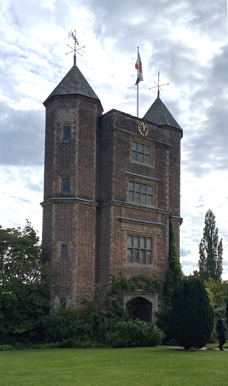
John Baker was the second son of Sir John Baker, and was born in 1531. He married Catherine, born in 1547, daughter of Sir Reginald Scott of Scott's Hall, Kent, England. He died 1606.
Sir Richard was born in 1568 at Sissinghurst, Kent, England, to John Baker and his wife Catherine. Sir Richard married Margaret Mainwaring in 1600, and they had three sons and four daughters. He was knighted in 1603 by King James I. Sir Richard possessed the manor of Middle Aston, and other estates in Oxfordshire and served the office of high sheriff for that county in 1620. He bore the burden, however, of some debts of his wife's family, and died on February 18, 1645 and was buried in St. Bride's Church, Fleet Street. While in prison, Sir Richard was the author of "Chronicle of the Kings of England". This popular printing was first published in 1641 and went into nine editions before 1696. From the book by Andrew Kippis, Biographia Brittanica, "....his mother was Catherine, daughter of Sir Reynold Scot of Scott's Hall in Kent, Knight, and his father John Baker of London, Gentleman, a younger son of Sir John Baker of Sissingherst.....Knight, Chancellor of the Exchequer, and one of the Privy-Council to King Henry VIII. Our auther was entered a Commoner of Hart Hall in Oxford, in 1584; and matriculated in Michaelmas-term the same year, being in the sixteenth year of his age. After he had spent in this place about three years, in the study of Logic and Philosophy, he went to one of the Inns of Court, and compleated his education by travelling into foreign parts; nothing being omitted by his parents to render him an accomplished gentleman. In 1594, after the celebration of a solemn act, he was, with other persons of quality, created Master of Arts at Oxford; and in May, 1603 he received the honour of knighthood from King James I at Theobalds. At that time, he lived in Highgate near London, and was esteemed a most compleat and learned person. In 1620 he was a High Sheriff of Oxfordshire, being possessed of the manor of Middle Aston and other estates in that county and was also a Justice of the Peace for the same. He had married Margaret, daughter of Sir George Mainwaring of lghtfield in Shropshire, Knight, which marriage caused him a great deal of trouble, and involved him into inextricable difficulties. For, engaging unwisely for the payment of some of that family's debts, he was thereby reduced to poverty and forced to betake himself for shelter to the Fleet prison, where he composed several books; and so reaped in his old age, the benefit of his learning, when his considerable estate, through surety-ship, was very much impared. At length, after a life full of troubles and cares he died very poor in the Fleet prison in London, February 18, 1644-45 and was buried the next day about the middle of the fourth aisle of St Bride's Church in Fleet street. He was a person tall and comely, of good disposition and admirable discourse, religious and well read in various faculties, especially in Divinity and History."
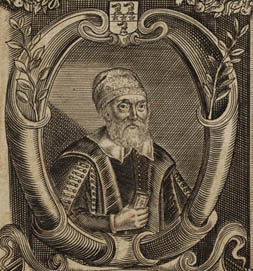
Margaret Mainwaring, born in 1570, married Sir Richard Baker in 1600. Margaret's ancestry could be traced back to Robert I, Duke of Normandy. Robert's son was William the Conqueror and his son was King Henry I. King Henry's only son died in a shipwreck and his daughter Matilda, who had been Empress of Germany, was forced to marry Geoffrey IV, the first Plantagenet, so called because of the sprig of flower, which he wore. He was much younger than Matilda, and their son became King Henry II, who married Eleanor of Aquitaine, the only woman to have the distinction of being Queen of both France and England.
Margaret Mainwaring's father was Sir George Mainwaring who married Anne Moore. He was born before 1551 at Ightfield, Salop and died in 1628. In 1608, he was the High Steward of Wem. Anne Moore was the daughter of Sir William Moore of Lassley County, Surrey. When Sir George married Anne, he acquired with her a good estate at Chertsey.
Sir Richard Baker had several children. From the Biographia Britannica by Andrew Kippis: "...by his wife Margaret...he had issue Thomas, Arthur, Cecilia, Ann, Margaret, &c." The notation "&c." may indicate more children, including Mainwaring Baker who died young, and Frances Baker. Margaret Mainwaring Baker died after her husband in 1654.
Thomas Baker was a younger brother of Sir Richard Baker, the Chronicler. He was born 1577 and married Ann. While the Baker family was originally English, Thomas came to Ireland most likely in the retinue of the Earl of Essex. By the 1630s, he had built up a sizable estate, which he was renting from Irish Catholic landlords in the townland of Ballinagleragh, which adjoins and lies to the east of Lattinmore, County Tipperary. He had a son Walter Baker, born 1623, and five others. In 1641, Thomas was residing with his wife and six children at Knockordan where he had a sizable estate. However, during the Great Rebellion of 1641, Thomas Baker held his castle at Knockordan for sixteen weeks against the rebels, but died in January, 1642. Just two days after Thomas died, the family was forced to surrender the castle. Thomas' widow, Ann Baker filed a deposition in July, 1642, giving account of the seige at Knockordan and the indignities endured by her family.
It has been written that Thomas Baker who settled in Ireland was "apparently" the second son of John Baker of Sissinghurst Castle. In 1842 Godfrey Phipps Baker wrote a letter to his nephew in Canada, explaining that we are "by tradition" descended from the Bakers of Sissinghurst. Several letters were written throughout the 1800s by family members who were searching for definitive proof of this heritage. One researcher visited Oxford University in search of this connection. In the 1880s, letters among Baker relatives were written, and several hand drawn family trees were produced. These letters continued in correspondence which has been carefully saved, and passed on to descendants.
The 'definitive' Baker family history was compiled by Sir Augustine Fitzgerald Baker M.A. in June 1922. Sir Augustine Baker could find no proof that the Baker family of Ireland was connected to or descended from the Bakers of Sissinghurst. Sir Augustine was specifically looking for the connection to Sir Richard Baker, the author of A Chronicle of the Kings of England; the timeline did not fit. However Thomas Baker who came over to settle in Ireland might very well have been the younger brother of Sir Richard Baker, as noted above. Sir Augustine's typewritten and bound book of over 100 pages was researched by reaching out to known connections around the globe, and by examining records at the Public Record Office, the Library at Trinity College, and the Registry of Deeds. By some stroke of luck, Sir Augustine F. Baker had completed his research just prior to The Four Courts blaze in June, 1922 at Dublin, Ireland, during the Irish Civil War. Nearly all Irish genealogical records were destroyed in this blaze; relatives in Canada were "horror stricken" at the news.
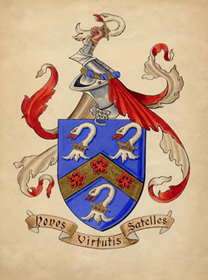
As Sir Augustine was completing his book, he applied to the Office of The Ulster King of Arms for the Arms of William Baker, Sheriff of Tipperary 1726. Those arms were confirmed April 29, 1921. The handpainted scroll was packed in a leather cask and sent overseas to Hugh Cossart Baker of Hamilton, Ontario. This precious gift has been passed down through generations to family members and its importance continues to be valued today.
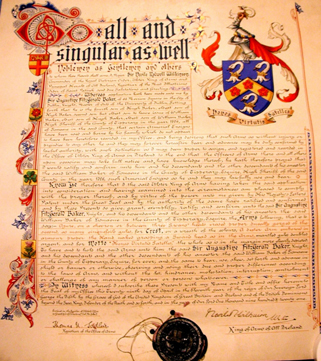
TO ALL AND SINGULAR AS WELL: Noblemen, as Gentlemen and others, to whom these presents shall come, I, Major SIR NEVILE RODWELL WILKINSON, Commander ofthe Royal Victorian Order, Ulster King of Arms and Principal Herald of All Ireland, Registrar of the Most Illustrious Order of Saint Patrick send due Salutations and Greeting. WHEREAS application hath been made unto me by SIR AUGUSTINE FITZGERALD BAKER, of 56 Merrion Square in the City of Dublin, Knight, Master of Arts of the University of Dublin, setting forth that he is the fourth son of Hugh Baker, eldest son of Hugh Baker, second son but eldest son to leave issue of William Baker, High Sheriff of the County of Tipperary in the year 1726, all of Lismacue in the said County, that certain Armorial Ensigns have been used and borne by his family which do not appear to have been heretofore recorded in my office, and being desirous that such Arms as without injury or prejudice to any other be and they may forever hereafter bear and advance may be duly confirmed by lawful authority, with such distinction as I may deem proper to assign, and registered and recorded in the Office of Ulster King of Arms in Ireland to the end that the Officers of Arms there and all others upon occasion may take full notice and have knowledge thereof he hath therefore prayed that I would ratify and confirm unto him and his descendants and the other descendants of his ancestor the said William Baker of Lismascue in the County of Tipperary, Esq., High Sheriff of the said County in the year 1726, such Armorial Ensigns as he and they may lawfully use and bear. KNOW YE, therefore, that I, the said Ulster King of Arms have taken the said application into consideration and having examined into the circumstances am pleased to comply with the prayer thereof, and by virtue of the power unto me given by His Majesty's Letters Patent under the Great Seal and by the authority of the same have ratified and confirmed, and by these presents do give, grant, exemplify, ratify and confirm unto the said Sir Augustine Fitzgerald Baker Knight and his descendants and the other descendants of his ancestor the said William Baker of Lismacue in the County of Tipperary Esquire, the ARMS following, that is to say: Azure on a chevron or between three Swan's heads, erased proper ducally gorged of the second, as many cinquefoils gules, for CREST on a wreath of the colours, A dexter Arm, embowed in armour proper, the Hand naked grasping a Swan's head as in the Arms, mantled gules doubled argent, and for MOTTO "Honos Virtutis Satelles", the whole as in the margin more clearly depicted. To have and to hold the said Arms unto him the said Sir Augustine Fitzgerald Baker, Knight and his descendants and the other descendants of his ancestor the said William Baker of Lismacue in the County of Tipperary, Esquire, for ever and the same to bear, use, shew, set forth and advance, in shield or banner or otherwise, observing and using their due and proper differences according to the laws of Arms, and without the let, hindrance, molestation, interruption, controlment or challenge of any manner of person or persons whatsoever. IN WITNESS WHEREOF I subscribe these Presents with my Name and Title and hereunto affix the seal of my office this Twenty-Ninth day of April, in the Eleventh year of the reign of our Sovereign Lord George the Fifth by the Grace of God of the United Kingdom of Great Britain and Ireland and of the British Dominions beyond the seas, King, Defender of the Faith, and so forth, and in the year of our Lord One Thousand Nine Hundred and Twenty-One. Entered in the Register of Ulster's Office in Grants and Confirmations Vol. M. Folio 7. NEVILE R. WILKINSON, ULSTER King of Arms of all Ireland. THOMAS N SADLEIR, Registrar of the Office of Arms.
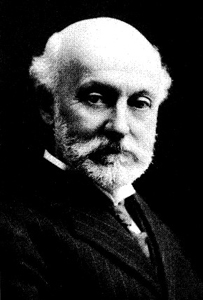
The Chronicle of the Baker Family in Tipperary was completed with a date of June, 1922. Sir Augustine Baker died just a few months later on October 7, 1922 at his residence at 56 Merrion Square, Dublin, Ireland. We are grateful for his work in researching and preserving the Baker family history for generations to come.
Walter Baker was the son of Thomas and Ann Baker, born 1623 at Ballinagleragh, Tipperary, Ireland. In 1640, at the age of 17, Walter Baker was enrolled at Trinity College in Dublin, Ireland. In 1641, the Baker family was turned out from their lands during the Great Rebellion of 1641, and the family home at Knockordon was destroyed. In 1667, Walter Baker was later able to recover some of his property. Walter married Martha Osborne and they had five children, Thomas, Richard, Walter, Martha and Mary Baker. Walter Baker died in 1669 at Lattinmore, Tipperary, Ireland.
Richard Baker was of Lattinmore, County Tipperary, the second son of Walter Baker and Martha Osborne. As his older brother Thomas died childless, the estate passed to Richard Baker upon the death of his brother. He had three children, William Baker, Baraby Baker and Walter Baker.
William Baker was born in 1676, Doonass, Clare, Ireland, the son of Richard Baker. He married Margaret Massy July 17, 1700; Margaret Massy was the eldest daughter of Hugh Massy of Duntryleague, County Limerick, and his wife Amy Benson.
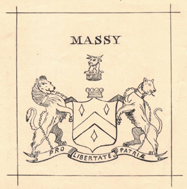
William Baker became High Sheriff of County Tipperary in 1726. He purchased the estate of Lismacue in 1705, which has remained in the family to the present day. The beautiful home, built in 1813, has been restored and today is operated as a bed and breakfast. As presented in the brochure, "Lismacue is a classic and beautifully proportioned Irish country house. It lies in its own extensive grounds at the foot of the magnificent Galtee Mountains. The house itself is approached via one of the most impressive lime tree avenues in Ireland. Your first glimpse of Lismacue House, as you breast the avenue's hill, will live with you forever, as its timeless beauty takes your breath away."
William Baker and his wife Margaret Massy had ten children altogether; Hugh Baker married Katherine Ryves and was the eldest and who died 1770, William Baker died unmarried in 1733, Godfrey Baker died 1788, Charles Baker, Thomas Baker, Walter Baker all died unmarried, Margaret married Reverend Godfrey Massy, Elizabeth married Richard Bolton, Alice married John Shepherd, and Amy Baker died unmarried.
Godfrey was born 1714 in Tipperary County, Ireland. He was the third son of Willam Baker and Margaret Massy/ He was a merchant, active in the affairs of Cork--he was Water Bailiff and Alderman, and from 1769 to 1770 he was Mayor of Cork. The Cork Directory for 1787 shows him as a Water Bailiff on the south mall. Godfrey married, in 1744, Elizabeth Cossart, daughter of Peter Cossart of Cork (c1693-1744) and Elizabeth Perdriau.
The lineage of Elizabeth Cossart, wife of Godfrey Baker and daughter of Peter Cossart and Elizabeth Perdriau Cossart.
Information presented below on the Cossart Family was taken from the chapter "Cossarts of Rouen", from the History of the Cossart and Allied Families by C.E. Cossart, 1947, found in the Family History Library of the Church of Jesus Christ of Latter Day Saints, Call Number 929.294 C822a. Some data contained in the above Cossart history may have been copied from a book published in 1923 - "The Early Generations Of The Du Pont & Allied Families;" by Colonel Henry Algernon Du Pont 1838-1926 (664 pages in two volumes). Chapter 19 of the Du Pont book is dedicated to the "The Cossarts" and includes some of the information published by C. E. Cossart in 1947.
The Cossart line can be traced back to 1429 in Rouen, France, where Pierre Cossart, of the parish of St. Jehan, was a maker of weights and scales. The ancestor of the Cossart line that married into the Baker line was Thomas Cossart, who lived in Rouen in 1514 and married Jehanne Fleury. Thomas and Jehanne had eleven children. He brought his sons into his business of dyes--dying yarns and cloth, which business had brought him wealth. He purchased two "seigneuries" for his two sons: for Thomas, he purchased the Seigneurie de Franqueville and for the younger son Jehan he purchased the Seigneurie de Boschestre. During this time, the Huguenots were gaining popularity and while both sons had been raised Catholic, Thomas left the Catholic Church and joined the Huguenots. When the Reformation came, the Cossarts were split--some remained Catholic and some Huguenots. Most of those who had joined the Huguenots ended up leaving France due to religious persecution.
Jehan Cossart, Thomas' second son, born about 1500, married Jacquette Puchot, who was born about 1511, daughter of Nicholas Puchot (c1455 to c1529) and Alizon Fere (c1488-1554). They married in December of 1529 or early in 1530. Jehan, through his own labor during his working life, amassed a fortune of his own in addition to the wealth inherited from his father. Jehan and Jacquette had twelve children, three of whom left the Catholic church to become Huguenots. The 5th child, and third son, Jacques Cossart, who married Marguerite Toustain, became the head of the Huguenot branch of the Cossart family in Rouen. Jehan died in June of July of 1585.
Jacques Cossart, son of Jehan Cossart and Jacquette Puchot, married Marguerite Toustain on April 22, 1577. Marguerite was the daughter of Laurent Toustain (1533-1594) and Marguerite Le Conte. Jacques died in 1609 and Marguerite died January 28, 1638 in her 78th year. Jacques and Marguerite had fourteen children.
The 6th child of Jacques Cossart and Marguerite Toustain was Pierre Cossart, christened January 3, 1585 in Rouen, France. He married Marie Baudouyn August 30, 1615. Marie Baudouyn was the daughter of daughter of Jehan Baudouyn and Marie Mayer. They had fourteen children. Pierre died after 1638 while Marie died August 24, 1646.
Pierre Cossart, was the 2nd son born to Pierre Cossart and Marie Baudouyn Cossart, and married Marie Loquet, daughter of Jehan Loquet and Marie Le Blanc. Marie was born in 1621 and she died before October 2, 1668. They married on January 24, 1644 in Rouen. Pierre and Marie moved to Rotterdam, Holland about 1681 and then to Amsterdam in 1701. They joined the Reformed Church of Amsterdam on November 13, 1701. After Marie Loquet died, Pierre was remarried to Elizabeth Bauquemare, born in 1634, the daughter of Nicolas and Marie Moysant. They married on June 14, 1674, but there were no children from this union. Pierre died after November of 1701. Pierre and Marie Loquet Cossart had ten children.
Isaac Cossart, was the 6th child born to Pierre Cossart and Marie Loquet Cossart. He was born September 30, 1651 in Rouen, and married Suzanne Cornelie de La Fontaine on March 15, 1690 in Amsterdam, North Holland, Netherlands. She was born about 1668 and died in early 1713. From the "Early Generations of the DuPont and Allied Families", pages 654 and 655: Isaac Cossart "was living" in Rouen "on the 16th of November, 1683, at which date he assigned a mortgage of 3,100 livres to Louis Le Buffier upon the latter's payment of the principal in cash, the validity of the mortgage being guaranteed by Isaac's father, Pierre Cossart. In this assignment Isaac is qualified as 'marchand demeurant rue Potard,' and as his father's domicile was in that street he no doubt was living with him. Isaac evidently left France in 1684, as he joined the Huguenot Church of Leyden, Holland, in June of that year. Later he removed to Amsterdam, which became his permanent abode and where he espoused" Suzanne Cornelie de La Fontaine, "of Huguenot extraction like himself"......"On the 20th March, 1710, Isaac Cossart, his son Pierre Cossart, as well as his daughter Marie Catherine Cossart, were naturalized as subjects of Holland. It is to be noted that no reference was made to his wife, Suzanne Cornelie de La Fontaine, perhaps because she had taken an oath of allegiance to that country previous to her marriage. She was living on the 11th of September, 1712 and must have died early in 1713, as on the 15th of March of that year, her husband, as surviving testator, appeared before Paul Van den Ende, notary public.....and executed a codicil confirming the provisions of the joint will of 1707.......Isaac Cossart survived his wife and died at Amsterdam January 15, 1715."
Suzanne Cornelie de La Fontaine and Isaac Cossart had eleven children, but only three of them survived to adulthood. Pierre Cossart, the second son was baptized on November 8th, 1693. He eventually left for Ireland, where he came to be called Peter Cossart, father-in-law of Godfrey Baker.
From the Early Generations of DuPont and Allied Families: "He joined the Reformed Church of Amsterdam July 27, 1711, and nearly five years afterwards, May 11, 1716, upon the eve of his departure for Ireland, received a certificate of membership therein. He established himself permanently in Cork. His nuptials took place in April, 1720, and the marriage licence qualified him as of 'St. Mary, Shandon, Cork, merchant' and the bride being Elizabeth Perdriau, likewise of 'St. Mary, Shandon', daughter of David Perdriau, Esquire."
Peter Cossart and Elizabeth Perdriau were married 1720; on this record her name is spelled Perdrau. Their daughter, Elizabeth Cossart was born July 30, 1725 in Cork, Ireland.
Godfrey Baker of Cork and Elizabeth Cossart were married in Glanmire, Cork, Ireland on July 14, 1744.
From the book "The First Indian Author in English: Dean Mahomed (1759-1851) in India, Ireland, and England", by Michael H. Fisher, Delhi, Oxford University Press:
"One branch of the Baker clan prospered in Cork city. In the early 1740's, Godfrey Baker, (father of Godfrey Evan Baker) moved as a young man to Cork and soon established himself as a leading merchant, apparently in international trade. As only the seventh son of the family patriarch (William Baker of Lismacue), he had apparently not seen a promising future on the family estates. In 1744, Godfrey married Elizabeth Cossart, daughter of Peter Cossart, a leading burgher of Cork. Godfrey Baker rose quickly in Cork society, voted by the Cork Council into the ranks of 'Freemen' in May, 1754." page 206
"He immediately took a particularly active role in city government: in 1755, the Council selected him to oversee repairs to the City Court House and the Freemen elected him one of the two city Sheriffs. The next year, he became a Burgess of the Cork Corporation. He won elections as Chief Magistrate, then as Mayor. This one-year mayoral term (October 1769-October 1770) brought with it a fine house, a salary of £100 and an allowance for public expenses to match. After his term as Mayor, Godfrey consequently became an Alderman for life. Status as an Alderman also ensured a life pension of £20 annually for Baker's widow. Baker also placed himself among the civic leaders particularly opposed to Irish separatism; for example, when troops were raised in March, 1778 to put down unrest, Godfrey Baker's name headed the list of leaders. He also held magisterial powers which he actively used to maintain social order. The Freemen of Cork annually re-elected Godfrey throughout the 1780's to the important office of Water Bailiff: the manager of the harbour and trade, with a handsome salary of £60 annually plus expenses and a silver oar as his badge of office. Further, he kept about £200 annually as his share of the port duties and deposited the surplus, about £100, in the Corporation treasury, one of the Corporation's major sources of income, illustrating both the value of this office, and Baker's powerful control over it for nearly a decade, on the day after his death in office (17 September 1788), an immediate electoral and political struggle for possession of this lucrative office broke out; subsequently the Corporation reduced its emoluments." page 207
"During his life, Godfrey Baker made careful efforts to retain his family's prominence in the city and region. As was customary, Godfrey arranged for the Cork Corporation to elect his eldest son, Godfrey Evan Baker, as a Freeman of Cork (July, 1782)." "Godfrey Baker also broadened his family's position in Cork society. Besides shifting from landholding to international trade and city government, he located his sons and daughters in other sectors of the elite. Godfrey admired the military; for instance, he helped sponsor a history of the military conquest of Ireland by the English. He also placed three of his four sons in army careers, while seven of this grandsons became military officers. His other son, Peter, obtained the Clerkship in the Permit Office. The Baker family remained prominent civic leaders until the end of the eighteenth century, leading efforts to succor the poor and defend the established elite." pages 207-208
From the Dublin Freeman's Journal, September 23-25, 1788 edition: "Died: In Cork, Godfrey Baker, Esq. one of the Aldermen of the ward, and Water-bailiff of that city". His date of death was September 17, 1788.
When Godfrey died, in 1788, "with him much of the family's access to patronage in Cork city government" also lessened. Elizabeth Cossart Baker, wife of Godfrey Baker died April 1, 1792 in Cork City, Cork, Ireland.
1.) Elizabeth Baker, born about 1746, and who married Nicholas Wrixon on September 13, 1776. From the Dublin Hibernian Journal, a Dublin newspaper, 25 September, 1776: "A few days ago at Corke Nicholas Wrixon to Miss Eliza Baker, daughter of Godfrey Baker, Esq."
2.) Godfrey Evans Baker, the eldest son was born July 4, 1750 and died in 1786. In 1768, he went to India to serve in the Artillery of the Honourable East India Company's Service. After 17 years, he returned to Ireland and married Margaret Massy (1759-1838), daughter of Hugh, 1st Lord Massy and Rebecca Delap. They lived in England, and had a son, Godfrey Hugh Massy Baker, born May 4, 1786 and who died January 1, 1877 at the age of 92. Later in life, he was of Grove Hill House, Chislet, Kent.
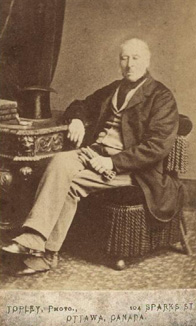
Godfrey Hugh Massy Baker, born 1786, married Elizabeth Grace in 1812 and had one daughter, Eleanor who married Richard Coxwell Rogers of Dowdeswell Court, Cheltenham on September 5, 1848. Eleanor died 1894. After the death of Godfrey Hugh Massy Baker's first wife, Elizabeth, he remarried. His second wife was Sarah Bennett and they had three children, Charles, Hugh, and Margaret.
3.) Peter Baker, was born about 1754 at Glanmire, Cork, Ireland, and never married. He was involved in an accident while travelling to Cork and died later at his home at 73 Aungier St., Dublin. From the Cork Advertiser: 22 May, 1813: "On Saturday at his house in Aungier St., Dublin, Peter Baker, Esq., attorney at law".
4.) William Massy Baker, of Glanmire, was born September 5, 1759 and left Cork in 1778 to join the Indian army. He returned 25 years later a retired Colonel in H.E.I.C.S. He brought his daughter Eliza, born 1765, with him from India, where her mother had died. William bought the estate at Fort William, Cork and married Mary Twogood Davies February 19, 1807. Mary was the only child of Reverend Richard Davies. From his marriage to Mary Twogood Davies, William Massy Baker had several children as follows: Godfrey Thomas Baker, born April 18,1810, who married Maria Elizabeth Oliver, and who died 1889; William Baker who married Frances Rentel Simpson; and died 1877; James Swayne Baker who died 1871; Hugh Percy Bakerwho died 1840, Richard Davies Baker who died 1873; Dorcas French Baker who died 1828, Katherine Pope Baker who died unmarried 1903; and Eleanor Davies who maried Edward Garde. William Massy Baker died November 12, 1829.
5.) Hugh Cossart Baker, was born September 3, 1760 at Glanmire, Cork, Ireland. In his military service, he attained the rank of Captain in the 27th Regiment of Foot. Hugh married Dorcas Phipps was born at Glanmire, Cork, Ireland in 1786. From Gentlemen's Magazine, August 1802, "At Cork, Hugh Cossart Baker, esq. formerly captain in the 27th Foot, in which he served during the whole of the American War, On the formation of the yeomanry he was appointed Captain of the grenadier company of that well desciplined corps the Royal Cork Volunteers. He was also judge advocate of Munster Province."
6.) Catherine Baker, was born December 16, 1762 at Glanmire, Cork, Ireland, and married Thomas Pope in 1797 in the Diocese of Cork & Ross, County Cork, Ireland. From the Hibernian Chronicle, a Cork newspaper, 23 Jan., 1797: "Last Saturday Thomas Pope Esq., attorney to Miss Baker, daughter to the late Alderman Baker". She died January 18, 1836
Dorcas Phipps was the daughter of George Phipps; she was born in 1766. Records show she died a widow at age 54 at Plumstead, Kent, in February, 1820 and was buried at Greenwich on February 22, 1820.
Dorcas' father was George Phipps from Cregg, Galway, Ireland, born about 1734. George Phipps was the son of Benjamin Phipps and Jane Croker, who had married in 1733. George Phipps died September 16, 1790 in Cork.
Dorcas' mother was Dorcas Pedder, who was christened November 30, 1736 in Cork City and who died May 6, 1820. Dorcas Pedder was the daughter of Belcher Pedder of Castle Berry, Ireland. Belcher was born about 1702 and married Dorcas Norcott about 1731 in the Diocese of Cloyne, Ireland. Dorcas Norcott was the daughter of William Norcott and Dorcas Lawton. Belcher Pedder died March 23, 1768 in Cork City, aged 66. He is buried in Buttevant, County Cork, Ireland. Dorcas Norcott Pedder died July 13, 1793 in Cork City.
1.) Godfrey Phipps Baker, the eldest son was born 1786 and was baptized April 12, 1786. He was nominated on February 3, 1801 as a cadet in the Bengal Establishment. He arrived in India 1802, became Lieutenant 1803, Captain 1814, and Major 1824 with the 19th Bengal Infantry. He became Lt. Col. April 22, 1827 and retired in India Jan 21, 1831. In the years 1811-1826, while in Java dring the British occupation of the island, Lt. Col. Baker was commissioned to create watercolours and drawings along with a map of Java; these served for military and political purposes. A group of 137 watercolours and drawings are held by the Library of the Royal Asiatic Society. In addition, the British Library holds official papers and reports on the Island of Java to Lieutenant-Governor Sir Thomas Stamford Raffles with notes by Lt. Col. Godfrey Phipps Baker. These sketches, watercolours and notes are considered to be very important to the history of Java in the early 19th century.
Godfrey Phipps Baker married Marie Lydie Dubois de Saran on July 22, 1817 at Chandernagore, India. Lydie was the daughter of Dubois de Saran who was the registrar at Chandernagore, India. In 1842 Godfrey P. Baker wrote a letter from Orleans, France, to his nephew, Hugh Cossart Baker where details of the history of the Baker family are given. Lt. Col. Baker mentioned his two daughters, Mary and Sophie in his letter. Both Mary Eliza and Sophia Eliza were baptized on December 20, 1822 in Calcutta, West Bengal, India. Sophia Eliza Baker, born 1816, married Jean Joseph Fortuné de Bourrousse de Laffore on April 16, 1844 at Bath, Somerset, England. He was an advocate, the son of the mayor of Laplume, France. Sophia Eliza died a few months later on February 9, 1845 at Agen, Lot-et-Garonne, France. All her books and other articles were left with her father at the time of her death. Mary Eliza Baker, who was adopted, married Charles Cesar Fleury Bettini in 1842. They were living in Florence, Italy in 1849 at the time Col. Baker wrote his will. Mary Eliza and her husband Charles Cesar Fleury Bettini had three children; Goffredo Bettini (1845-1866), Giulia Bianca Baker Bettini (Oct 21, 1848-Dec 17, 1848), and Elisa Bettini (1848-1910).
Stuart P. Wilkinson, a trustee of Lister Lane Cemetery in Halifax, UK provided additional information on the life of Lt. Col. G.P. Baker. He was a charitable man who in 1849 provided funds for the burial of his housekeeper, Ann Broadrib. Her monument at Lister Lane Cemetery is similar to his, and reads,"Sacred to the Memory of Ann Broadrib who Died the 25th day of April, 1848 in her 29th year. This tribute of gratitude for her honest, faithful and zealous services as housekeeper, was erected by her master."
Lt. Colonel Godfrey Phipps Baker died August 4, 1850 at the age of 65. He is buried at Lister Lane Cemetery, Halifax, UK. His last will and testament names his brother Captain Hugh Cossart Baker, and his friend, Richard Hart of Halifax, UK to be executors and trustees. Evidently Lt. Col. Baker had moved to Halifax, UK from Orleans, France to be in the vicinity of his good friend and colleague, Richard Hart.
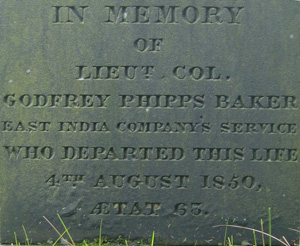
His last will and testament mentions that books and other articles that belonged to his late daughter Sophia were to be passed to her mother, Mary Lydie. In addition, Miss Mary Grantham of Hamilton Terrace, St. Johns Wood in London, was to receive £500. Interestingly, Grantham is a name given to one of Lt. Col. G. P. Baker's nieces, Frances Marianne Grantham Baker. Also, some documents name Mary Grantham as the mother of Sophia Eliza Baker. Most of the last will and testament of Lt. Col. G.P. Baker pertains to ensuring his remaining adopted daughter Mary Eliza Bettini is provided for, along with his wife. Marie Lydie Dubois de Saran Baker, the widow of Lt. Col. Godfrey Phipps Baker died in the city of Niort, France on June 19, 1873, with a niece handling her estate.
2.) Captain George William Baker was born in Dublin, Ireland July 12, 1790 and died in Bytown, Canada West, which later became Ottawa, Ontario, Canada on July 22, 1862. He married Ann Cole July 8, 1817 at St Giles, Norwich, Norfolk, England. Note that this line continues below after the image of Captain George William Baker.
3.) Hugh Cossart Baker, who was born about 1792 and married Mary Anne Popplewell, daughter of James Popplewell. They were married December 8, 1836 at the Old Church, Saint Pancras, London. They had three children: Reverend Hugh Swayne Baker, who was born June 30, 1838 and who died October 30, 1865 at Notting hill, England. He is buried at Kensal Green, Kensington, Catherine Henrietta Baker, christened November 1, 1843, Bletchingly, Surrey, England. She married, in 1865, Augustin William Langdon, and they had 8 children. Catherine Henrietta Langdon died May 31, 1914 at the age of 70 and is buried at Hastings, East Sussex. Godfrey Phipps Baker was the thrid child, born June 23, 1846. Mary Anne Popplewell Baker died 1855 and her husband Hugh Cossart Baker died 1862 at the age of 70.
Hugh Cossart Baker (1792-1862) was a major in the Artillery. He was baptized in Galway, Ireland, April 15, 1792. He was a cadet in 1808 and was posted to India, arriving December 7, 1809. He became a lieutenant on April 21, 1817 and a captain May 21, 1824. He retired on July 9, 1835. He participated in the expedition against Mauritius 1810-11 and served in Bengal in August of 1811 in the 3rd Mahralta War. (List of the Officers of the Bengal Army 1758-1834 by Major V.C.P. Hodson, London, 1927.) From the London Times September 24, 1862--Deaths: On the 21st instant at his residence Tuscany Villa, Notting-hill, Major Hugh Cossart Baker, deeply lamented.
4.) Dorcas Baker, who married Lt. Col. Peter DesBrisay Stewart of the Royal Artillery. He was the son of Honorable Charles Stewart (about 1759-1813) and Mary DesBrisay (about 1764-1847). They married on February 9, 1810 in London. Charles Stewart was the son of Peter Stewart, Chief Justice of Prince Edward Island, and Mary DesBrisay was the daughter of Thomas DesBrisay, Lieutenant Governor of Prince Edward Island under Governor Walter Patterson. One of Thomas' sons, Theophilus, rector of St. Paul's Church in Charlottetown, married Margaret Stewart, a sister of Charles. Peter DesBrisay Stewart died on November 1, 1867 and was buried on November 4. Dorcas died on September 22, 1841 in Demerara, West Indies.
NOTE: The information on Dorcas and Peter DesBrisay Stewart represents the research of Don Lowe of Alberta, Canada, who kindly agreed to its use on this web page. His sources on this information include: Memorial Plaque displayed in St. Paul's Anglican Church, Charlottetown, Prince Edward Island, Canada; Tom Stewart, a descendant of Hellfire Jack Stewart; United States Government Social Security Death Index; Prince Edward Island Genealogical Society Cemetery Transcripts; research of Bruce Varcoe; Pollard's Historical Sketches; and the Provincial Archives and Records Office at Prince Edward Island (Beaconsfield Heritage Foundation, Charlottetown, Prince Edward Island).
The twelve children of Lt. Col Peter DesBrisay Stewart and Dorcas Baker were:
1. Lt. Charles Stewart, born May 19, 1813 in Woolwich, Kent, England. He was christened on October 24, 1814 and married Margaret MacLeod on January 10, 1832. He was killed in action January 13, 1842 in Gandamak, Afghanistan.
2. Hugh Cossart Baker Stewart, was born June 18, 1815, in Woolwich, Kent, England and christened September 8, 1815. He died May 13, 1829 in Prince Edward Island, Canada. He perished in a house fire while trying to save his younger sister Louisa.
3. Peter DesBrisay Stewart born October 28 1816 in Woolwich, Kent, England, and christened May 19, 1817. He died in July 1829 at Marleybone, England at the age of 13.
4. Edward Kent Stratheran Stewart, born October 29, 1818 in Woolwich, Kent, England, and christened May 20, 1819. He died 1825 in London, England at the age of 6.
5. Dorcas Octavia Pedder Stewart, born March 25, 1820 at Woolwich, Kent, England and christened June 28, 1821. She married Theophilus DesBrisay Esq. (1816-1884) on February 1, 1853 in Charlottetown, Prince Edward Island, Canada. Dorcas' husband Theophilus was the grandson of Rev. Theophilus DesBrisay, the first Protestant Minister (appointed 1774) to serve the Island, which was during his time known as St. John's or Isle St. Jean. Dorcas' husband, Theophilus DesBrisay was the mayor of Charlottetown and a pharmacist; he died March 30, 1884. The DesBrisay Block and Apothecaries Hall in Charlottetown, PEI is a National Historic Site. Dorcas died on June 21, 1909 and is buried at St. Peter's Cemetery, Charlottetown, Prince Edward Island, Canada.
6. Louisa Colebrooke Stewart, born May 26, 1821 at Woolwich, Kent, England, and was christened June 28, 1821. She perished in a house fire in Prince Edward Island on May 13, 1829 at the age of 8.
7. Thomas William Stewart was born July 20, 1822 at Woolwich, Kent, England, and christened July 4, 1827 in Woolwich, Kent, England.
8. Lestock Wilson Stewart Esq., M.D., who was born February 8, 1824 at Westminster, London, England and was christened July 4, 1824. He married Lillian Elena Emily Drury April 13, 1852 at Madras, India. He died May 4, 1876 at Trichinopoly, India.
9. Duncan McLeod Stewart, born Nov 4, 1825 at Woolwich, Kent, England, and christened January 30, 1827.
10. Mary Magdalen Stewart, who was born January 3, 1828 in Halifax, Nova Scotia, and married Col. William Southey of the 48th Madras Infantry on November 18, 1845 in London, England. William was born in 1824 and died in 1871 at the age of 47. Mary Magdalen Stewart died July 9, 1882 at Teignmouth, Devon, England. Children from this marriage were: Rosa Stewart Southey, born 1947; Charles Southey, 1848 - 1858; Henry Edmund Southey, 1850 - 1935; Maria Louisa Southey, born 1851; Edith Flora Southey, 1853 - 1911; Alice Marston Southey, born 1859; Susan Ellen Southey, 1860 - 1885; Robert Southey, born 1861; Mabel Southey, born 1862; Ethel Augusta Southey, born 1864; and William Melvill Southey, 1866-1939.
11.Hugh Massy Stewart, was born January 16, 1830 at Middlesex, England and was christened May 2, 1830 in England. He died July 24, 1905 at Victoria, Australia.
12. Flora MacDonald Stewart, born July 2, 1833. Flora married Benjamin de St.Croix DesBrisay (1827-1908) on October 12, 1865 in Charlottetown, Prince Edward Island, Canada. She died April 24, 1898 and is buried at Sherwood Cemetery, Brackley Beach, Prince Edward Island.
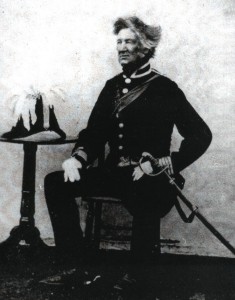
Death of Lieut. Col. Peter DesBrisay Stewart, from Pollard's Historical Sketches, pages 197-198.
The next death to record is that of the late Adjutant General Lieut. Colonel Peter D. Stewart, which sad event took place on November 1, 1867, at his residence, Spring Park. Colonel Stewart was born in Charlottetown in 1785, where his days ended at the age of 82 years. At the age of 14, he obtained a commission in the Royal Artillery, and as an officer of that regiment first performed garrison duty in the fortification of his native town. England being at war, young Stewart was present with the armament against Copenhagen in 1807. After a long service he retired from the army and returned to the land of his birth. Here on the retirement of Colonel Swabey, as the Adjutant General of Militia in 1859, Colonel Stewart received that appointment, in which he served to the period of his death. In connection with the venerable gentleman's journey through this life, we shall mention a most melancholy accident which happened in the year 1829. During that period, Captain Stewart was on garrison duty with his battery at Halifax, N.S., while Mrs. Stewart and family were passing the winter and spring at Charlottetown. On the 15th May, the family at the usual hour having retired to rest in apparent security from trouble, were awakened from their repose by the loud barking of their dog; in ascertaining the cause of this, the house was discovered to be on fire. The alarm being given the inmates were instantly removed in safety, except a little girl aged nine. Thereupon a noble minded boy, aged twelve, under the impulse of affection rushed into the burning house in order to save his sister and bring her forth but sad to relate, both were consumed in the devouring flames.
The plaque above honouring Peter DesBrisay Stewart reads as follows: In Memory of Lieut. Col. PETER DESBRISAY STEWART, Who died Nov. 1st 1867. Aged 83 years. He entered the army at an early age in the Royal Artillery Woolwich, serving with distinction at Copenhagen, West Indies, North American Colonies, and Ireland, when having attained the rank of Lieut. Col. he retired from the service, and returned to this Island, where he held the appointment of Adjutant General of the Militia & Volunteered, applying himself with zeal and ability to the reconstruction of the defensive forces of this his native land. The deceased was eldest son of Attorney General Stewart,and grandson of Chief Justice Stewart of this Island. This record of departed worth is erected by his family as a tribute to the memory of an indulgent parent, an efficient and devoted officer, and a warm hearted generous citizen. He will ever be remembered with affectionate regard.
Death of Dorcas Baker Stewart
From the Royal Gazette Tuesday, February 8, 1842--At Demerara, of Yellow Fever, the beloved wife of Major P.D. Stewart, Royal Artillery, after an illness of ten days, she departed this life on the 22nd of September, 1841, leaving a large family to deplore her loss. She was a kind and affectionate mother and sincere friend to all who knew her. She is deeply lamented by her friends--London Morning Herald, December 7.
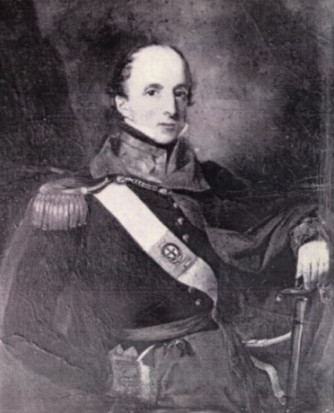
George William Baker was born in Dublin, Ireland July 12, 1790 and died in Bytown, Canada West, which later became Ottawa, Ontario, Canada on July 22, 1862. He married Ann Cole July 8, 1817 at St Giles, Norwich, Norfolk, England. They are shown on the register as George William Baker, bachelor of Woolwich, Kent, and Ann Cole, spinster of this parish, married by licence. Ann Cole was born April 2, 1786 and was Christened April 24, 1786 at the Old Meeting House-Independent, Norwich, Norfolk, England. Ann Cole died October 24, 1851 at the age of 65, in Bytown, Canada West, which later became Ottawa, Ontario, Canada. They are buried at Beechwood Cemetery, Ottawa.
The paternal great grandparents of Ann Cole, were James Cole (1683-1749) and Persis Scurry (1700-1754), who were married August 2, 1720 at St James Pockthorpe, Norwich, Norfolk, England. The nine children of James Cole and Persis Scurry were all born at Norwich, Norfolk, England, and baptized at The Old Meeting House, Norwich. They are as follows: Persis Cole, born June 3, 1721; Elizabeth Cole, born July 28, 1722; John Cole, born December 9, 1724; James Cole, born December 12, 1727; Mary Cole, born Sept 6, 1731; Samuel Cole, born April 6, 1734; Lougher Cole, born July 18, 1736; Thomas Cole, born February 24, 1739; Susana Cole, born Oct 11, 1743.
Ann Cole's grandfather, Samuel Cole, was born April 6, 1734, and was christened in Norwich, Norfolk, England on April 28, 1734. Samuel became a schoolmaster at Lynn Regis, and while residing there, he married Margaret Hammond, the daughter of a Doctor Hammond who was a physician there. (This information from the book, The Norfolk and Norwich Savings Bank, 1816-1901) Samuel Cole and Margaret Hammond (1732-1808) were married October 9, 1754 at All Saints Church at South Lynn, Norfolk. The groom's parish was Norwich, Saint Saviour. Notes indicate the groom was a minor. "Married By Licence With The Consent Of Persis Cole, Widow Mother Of The Said Samuel Cole, No Guardian Being Lawfully Appointed."
Samuel Cole and his wife, Margaret Hammond had nine children, all born in Norwich, Norfolk, England, and all baptized in the Old Meeting House, Norwich, The nine children were as follows: Elizabeth Cole, born July 17, 1755 and who died in 1757; John Hammond Cole, born December 3, 1756; Samuel Cole, born August 11,1758; Elizabeth Cole, born May 3, 1760; Margaret Cole, born August 19, 1763, and who died November 27, 1763: Jemima Cole, born January 3, 1767; Peggy or Margaret Cole, born September 28, 1768; Mary Cole, born July 16, 1770 and who died November 19, 1770; and Persis Cole, born July 12, 1772 and who died December 8, 1773.
Ann Cole's father was John Hammond Cole, born December 3, 1756. John Hammond Cole was baptized December 26, 1756 at Norwich, Norfolk, England. He married Ann Shenton (1766-1848), who was born in Buckinghamshire, England. John Hammond Cole and Ann Shenton married at St. Pancras Parish Chapel, London, on June 10, 1783. They had nine children as follows: John Shenton Cole, born May 25, 1784, and who served with the Madras Army and died in Cannenore, Kerala, India on June 28, 1809; Ann Cole, born April 2. 1786; Jemima Eliza Cole, born June 10, 1790 and who died April 11, 1862; Margaret Susannah Cole, born June 20, 1792, and who died and was buried October 10, 1792; Sarah Cole, born April 11, 1794, and who died April 26, 1794; Margaret Susannah Cole, born June 5, 1796; Frances Cole, born March 5, 1799, and who died Sept 13, 1858; Edward Cole, born August 4, 1803, and who died May 11, 1878 in Great Plumstead, Norfolk, England; and Marianne Cole, born July 24, 1811, and who died and was buried October 28, 1820 at the age of 9 years.
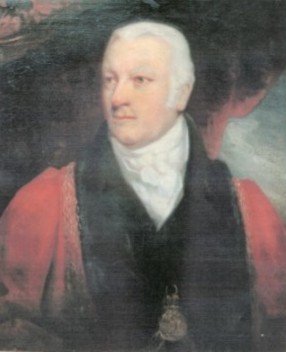
The original is in a beautiful gold frame. It was reframed and restored in 1945. The inscription below the portrait was typed out as follows: "This painting was brought to Bytown, now Ottawa, Ontario, by Captain George William Baker, R.A., in or about 1830. This portrait is of John Hammond Cole, Esq., the father of Ann Cole, wife of said Captain George William Baker. The following possible reference to this portrait is in the will of George William Baker 13th March, 1861: 'I give and bequeath to my brother-in-law the Reverend Edward Cole the pictures of his father and mother by the late Sir W. M. Beechy, Pres. of the R.A.' This painting was brought to Winnipeg with the G.P. Baker estate effects from Ottawa about 1910 and was given to F. C. Baker, my uncle, from whose estate I purchased it and had it restored and reframed in November, 1945." E.G.P. Baker
John Hammond Cole was described in 1811, in the book, "The Norfolk and Norwich Savings Bank, 1816-1901" as a zealous, public-spirited and philanthropic gentleman. He conceived the idea of providing a savings bank for the benefit of servants an apprentices. He set up a small bank in his home on St. Giles Street, and carried on business during one evening per week, with the assistance of his daughters. In 1816, a properly organized Savings Bank was evolved, when Mr. Cole was successful securing the cooperation of many prominent country and city gentlemen, who were interested in the welfare and prosperity of the city, and in the amelioration of the condition of the working classes of the community.
From the book "The Mayors of Norwich 1403-1835" by B. Cozens-Hardy and Ernest Kent, John Hammond Cole is shown as being sheriff in 1799, mayor in 1811 and alderman for the Mancroft Ward. John Hammond Cole was the son of Samuel Cole of Fisher's Lane, Norwich and began his professional career as a clerk in the Kerrison's bank. He was Treasurer to the Boys and Girls Hospital and the Norwich Dispensary and treasurer and secretary of the Norfolk and Norwich Savings Bank. This bank offered him the choice between having a portrait hung in St. Andrew's Hall and a piece of plate. He chose the plate, a silver tureen which was engraved with his crest and an inscription, "This piece of plate was presented by the Trustees and directors of the Norfolk and Norwich Savings Bank to John Hammond Cole, Esquire, in testimony of the valuable services which for several years he rendered to that institution." He was the Distributor of Stamps from 1793 until his death, the Stamp Office being at his house, 36 St. Giles Street. He chaired the meeting when the Norfolk and Norwich Auxiliary Bible Society was formed in 1811. He died November 29, 1828 at the age of 72. His wife was Ann Shenton of Buckinghamshire, who was born 1766 and died Feb 11, 1848. Both are buried in the south aisle of St. Giles Church; a mural monument marking their resting place.
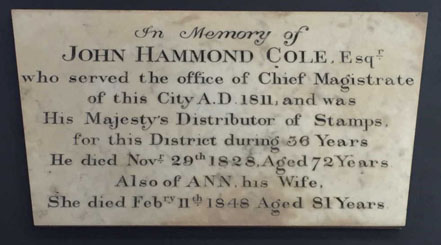
John Hammond Cole, father of Ann Cole Baker, died November 29 1828. From the Norfolk Annals, 1828-29 "Died at his house in St. Giles Street, Norwich, aged 72, Mr. John Hammond Cole, an Alderman of the Great Ward of Mancroft. He was sheriff in 1797; Mayor in 1811; Receiver of Stamp Dates; Treasurer of the Boys' and Girls' Hospital, and of the Norwich Dispensary, and Treasurer and Secretary of the Norfolk and Norwich Savings Bank". Ann Cole died February 18, 1848 aged 81: From the Gentleman's Magazine, "Norfolk, Feb. 11, At Norwich, aged 81, Ann, relict of John Hammond Cole, Esq." In her will, Ann took care to divide up the family heirlooms among her children. To her son Reverend Edward Cole, she gave the silver tureen which had been presented to "my late husband in consideration of his services in the savings bank". To her daughter Ann, wife of George Baker, she left "the portrait of my late son John Shenton Cole and the old china jug called in my family 'Ben'." To her daughter Frances Cole she left a "portrait of herself" and to her daughter Jemima Eliza Cole and her daughter Frances Cole she gave "all my wearing apparel and body linen to be divided between themselves". Additionally, she left to Edward Cole "our office press, a wardrobe, a library table, a small wainscot chest of drawers, a wainscot washing table with closet, a microscope in a mahogany box, a slipper bath, silver stand for a tureen, a telescope and a small mahogany chest of drawers". Since she had left so much to Edward, to divide her estate equally among her children, she took care that all the things she was bequeathing to Edward should be "valued" and after the rest of her estate had been sold, the money that was left after funeral expenses and debts had been paid, was to be divided among these children, deducting the value of the items given to Edward.
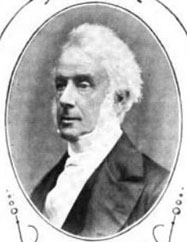
When John Hammond Cole died in 1828, his son, Reverend Edward Cole, Incumbent of the Parish of Great Plumstead, Norfolk, succeeded his father at the Savings Bank, but as honorary secretary, and held the office for close to fifty years. Edward was the brother of Ann Cole.
Ann Cole married George William Baker 1817, and came to Canada to settle in Bytown, Canada West. In addition to his wife, George William Baker brought two of his wife's sisters, Jemima Eliza Cole (1790-1862) and Frances Cole (1799-1858). Both Jemima and Frances remained unmarried and are buried in the Baker familly plot at Beechwood Cemetery, Ottawa.
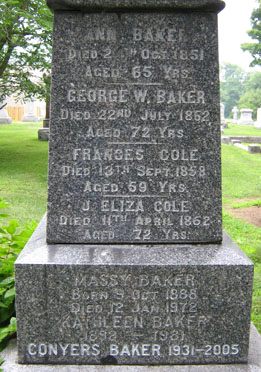
George Baker served in the 3rd Battery, Royal Regiment of Artillery. When he joined up, he was 15 years and 353 days old, almost 16. This regiment dated to May 26, 1716, when two companies of field artillery were formed at Woolwich during the reign of George I. Previous to this time, there was no permanent body of artillery in the British Army. When artillery was needed, it had to be authorized by Royal Warrant, and then was disbanded when no longer needed. This proved unsatisfactory during the Jacobite rebellion and thus the Royal Regiment of Artillery came into existence. George Baker is shown in their records as a cadet in 1804, a second lieutenant in 1806 and a first lieutenant in 1808. From 1809 to 1810 his service took him to Walcheren; from 1810 to 1812, Gibraltar; from 1812 to 1814, Malta; and from 1826 to 1829, Trincomalee, Ceylon. He retired from the service on June 23, 1832 after nearly 25 years of service to his country..
George Baker succeeded Matthew Connel as postmaster of Bytown (Ottawa) in 1834 when the current postmaster Matthew Connel died of cholera. The post office was moved from Connel's house on Lot G on Rideau Street in Lower Town, to Kent Street in Upper Town. George's eldest son Hugh Cossart Baker had charge of the office and George's second son Godfrey Phipps Baker as a young teenager helped out and eventually took over when Hugh moved to Toronto in 1846. Godfrey (see his section below) succeeded his father in 1857, when George resigned. (from Michael Newton's book Lower Town Ottawa.)
In these early days in the Canadian wilderness, George Baker worked hard to help out fellow settlers and may have served from time to time as an arbiter of disputes. From a letter written from Bytown April 6, 1835 to the Surveyor General: "Sir, I venture to address you at the particular request of pensioner George Lattimer who having received a ticket dated 15th April, 1833 for lot number 15 on the 8th Concession of Osgoode whereupon he went upon the lot, has built a log house, barn, etc., and cleared twelve acres". (It is worth mentioning at this point that the business of having cleared a goodly number of acres and built buildings was very important as one of the provisions in the land grants was that the settlers perform certain duties, among them clearing the land and erecting structures. On some of the censuses and assessments of early Canada some of the data collected included how many acres had been cleared out of the total granted and what type of buildings were on the land, what they were made of, and how many levels they consisted of.) "Finding the receipt of his location ticket a man named Hugh Mathews went upon the lot as a squatter and commenced clearing, but when the ticket arrived Lattimer showed it to Matthews who departed receiving from Lattimer six dollars for the work he had done, after this, however, and Matthews full well knowing that the whole lot belonged to Lattimer, the former procured (it is believed through M. Maclean) a location ticket for the east half of said lot and in spite of Lattimer has taken possession and built a shanty. It would appear that some deception must have been practiced to obtain the second location to part of a lot the whole of which had already been granted, but as Lattimer has performed all his settlement duties and has constantly resided on the lot, I am sure you will see the propriety of cancelling the location made to Hugh Matthews. I am, Sir, Your Very Obedient Servant."
In 1835 George Baker was authorized to raise two companies of volunteers in Bytown and he was to have the rank of Lieutenant Colonel. However, some of the local people, who were politically opposed to George Baker's Tory sentiments, tried to undermine his authority by contesting it in the court system and by writing letters to the government. His commission was revoked and the companies disbanded. However, in 1838 and 1839 he again held a militia rank.
In the 1840's George Baker was also a magistrate and once again commander of the Bytown militia and acted as the returning officer for the March, 1841 election. As a Tory, he was committed to the Governor's candidate, William Stewart Derbishire and "his children publicly sported Derbishire's banner and badges on election day". When Derbishire was declared the winner "George Baker stood on the platform and sang 'Rule Britannia' at the top of his lungs--then jumped into his sleigh and led the victory parade". (from Shirley E. Woods book Ottawa: The Capital of Canada.) His militia duties became complicated during the early years of Bytown when brawling, and episodes of violence increased as the Irish battled with the French Canadians for control of the jobs associated with the lumber trade. As the town magistrate, George Baker wrote the authorities for help and thus described the situation of the early Bytown into which he and his family had settled: "I cannot Sir describe to you the situation of the town. If I could, you would deem it incredible and it is becoming daily, worse...No person whatever can move by day without insult, or at night without risk of life--thus whole families of unoffending people are obliged to abandon the town and nothing except a military patrol will succeed in arresting the evil and dissipating the general alarm...I have not moved without arms since the 14th May". (From the book Ottawa: An Illustrated History)
George Baker was very active in a number of different venues: he was reeve of Nepean Township in 1842, 1843 and 1844; founded the Bytown Cricket Club in 1849. He was one of the first shareholders in the Bytown and Prescott Railroad (from Michael Newton's book Lower Town Ottawa and Shirley E. Woods book Ottawa: The Capital of Canada.). He was a member of the Dalhousie District Council from 1842 to 1850; president or director of the Mutual Fire Insurance Company of the Bathurst District; member of the Bathurst District Agricultural Society from 1832 to 1842 and served as the treasurer in 1837; member of the Dalhousie District Agricultural Society (renamed from the Bathurst District Agricultural Society) from 1842 to 1850; member of the County of Carleton Agricultural Society (renamed from the Dalhousie District Agricultural Society) from 1850 to 1854--perhaps longer; and a member of the Ottawa Horticultural Society, founded in 1854, until 1859, when the society ceased operations.
Apparently the idea that Bytown would someday be the capital was a very much discussed topic of conversation during the lifetime of George W. Baker. In a letter to a friend written in July of 1835, George Baker said: "Then will arise the all important question as to the site of the future capital. Quebec is too far distant from the west--Montreal indefensible and the St. Lawrence is too near the enemy. Thus I have made up my mind, that no part of Canada is so well fitted for the purpose as Bytown, with a more classical name. Bytown is equidistant between the two extremes and a reasonable distance from the frontier--the best military position in the province, and there is nearly enough stone about it for building purpose. With respect also to salubrity--it is not exceeded by any place in the world--then what villas there will be on our hills and what splendid fleets of yachts in our harbours."
A poem about George Baker appears in the book Recollections of Bytown and Its Old Inhabitants, by William Pittman Lett, published in Ottawa in 1874 and reflects the esteem in which he was held by his fellow townspeople:
George William Baker, better known as "Captain Baker" in the town.
Who oft the mailbag's lock untied
Long after Matthew Connell died--
Long after Helen Denny's hand sent postal letters o'er the land;
An Englishman of good degree
A Justice of the Peace was he, and Captain of Artillery--
He was in his life's early day,
He shewed his claims to education in County Council legislation,
Where he in intellectual pride sat long by Hamnett Pinhey's side,
Our local parliaments since then have seldom witnessed two such men.
When George Baker died in 1862, his last will and testament revealed a generous legacy to his children and close relatives. He had two lots--24 and 25 in the first Concession of the Township of Nepean, Ottawa front. He had a great deal of farming implements, plate, linen, books, furniture and family portraits. Additionally, he had land in Ireland which had been given to him by his grandmother Dorcas Phipps:
1.) Land in the townland of Upper Kilcummer, County Cork, Barony of Fermoy, parish of Kilcummer.
2.) Land in the townland of West Knocknanagh, County Cork, Barony of Duhallow, parish of Kilmeen.
3.) Land in the townland of Lahern, County Cork, Barony of Kinalea, parish of Leighmoncy.

Death Notice of Ann Cole Baker: Gentleman's Magazine, 1851: October 24, at Bytown, Ottawa River, Canada West, the wife of George W. Baker, late Captain R. Artillery, eldest daughter of the late John Hammond Cole, Esq. of Norwich.
Obituary of George William Baker: Ottawa Union, July 24, 1862: Ottawa has lost another of its oldest and most respectable citizens in the death of George W. Baker, Esq., lately of Woodroffe, in the township of Nepean. He died full of years, and honoured by the community in which he has moved for over a quarter of a century. The deceased was in early life a captain in the Royal Artillery. He was a man of varied attainments, ripe scholarship, and vigorous intellect. As early as 1835-36, Captain Baker was a leading magistrate of the town and took an active part in the municipal and political movements of the day. He was the first agent here of the Bank of Upper Canada, and held the position of Postmaster for many years, being succeeded in the management of the Post Office by his son, Mr. G. P. Baker, who has latterly and now conducts the business. The deceased retired some years since to his farm (Woodroffe) in the township of Nepean, and of late years his health had given way to a considerable extent. A short time since his residence was destroyed by fire and his valuable collection of papers and rare antiquities, as well as a large amount of valuable property, were destroyed. Since that period he has rapidly declined and his death took place rather suddenly on the 22nd instant.
George William Baker and Ann Cole were originally buried in the Sandy Hill Cemetery in Ottawa, but later transferred to the Beechwood Cemetery on September 12, 1883. A Baker family monument in the Sandy Hill Cemetery was unfortunately not transferred to the new family plot in Beechwood. In 1911, the Corporation of the City of Ottawa decided to plow over the former cemetery to turn it into a park. Headstones that were not transferred were transcribed into the Council Minutes for posterity. Buried on plot 44 of Beechwood Cemetery are the following: Godfrey Phipps Baker, died 1882, age 60; J. Eliza Cole, died April 11, 1862, aged 72 years; Frances Cole (from Sandy Hill, 1883), died Sept. 13, 1858 aged 59 years; George William Baker (from Sandy Hill, 1883); Annie Baker (from Sandy Hill, 1883); Eliza B. Baker (from Sandy Hill, 1883); Elizabeth C. Baker (from Sandy Hill, 1883); Marion J. Baker, died 1903 aged 70; Catherine E. Baker, died 1903, age 49, grave #2; Frances Amelia Baker, died 1930, age 85, grave #6; Massy Baker, born Oct. 9, 1889 and died January 12, 1972, age 84, grave #3; Kathleen Baker, died March 30, 1981, age 88, grave #4; Elizabeth Julia Baker, died Sept. 10, 1858, aged 26 years; Elizabeth Brickenden Baker died Sept. 15, 1853 aged 6 months; Irene Evans, died 1981, grave #5; and Denis Evans, died Aug. 20, 1986, age 60, grave #7.
The children of George W. Baker and Ann Cole and their descendants are featured on individual pages as follows:
Hugh Cossart BakerIf you wish to contact me about any of the above information,
please e-mail me, Linda S. Jordan at  .
If you wish to use any of the information found on my website, kindly e-mail
me and ask for my permission. Content copyright Linda S. Jordan 2003 - 2025
unless otherwise noted.
.
If you wish to use any of the information found on my website, kindly e-mail
me and ask for my permission. Content copyright Linda S. Jordan 2003 - 2025
unless otherwise noted.